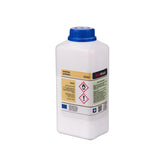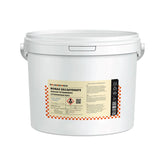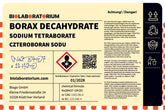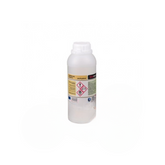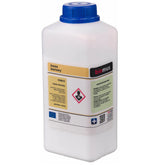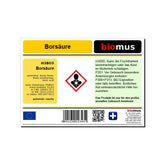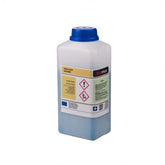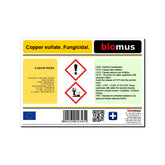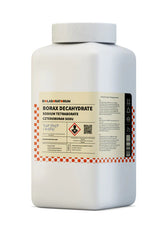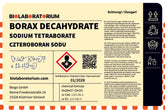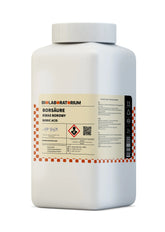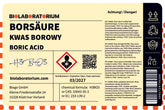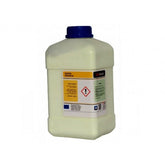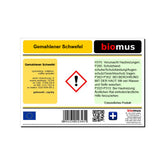Strontium sulfate – Versatile industrial raw material with special properties
Strontium sulfate, also known as strontium sulfate or SrSO4, is an important inorganic mineral that finds diverse uses in industry. As a naturally occurring mineral or as a synthetically produced raw material, strontium sulfate offers a range of interesting properties that make it a valuable component in numerous products and processes.
In this blog article, we will take an in-depth look at strontium sulfate – from its physical and chemical properties to industrial applications and safety aspects in handling. Let yourself be transported into the fascinating world of this versatile industrial mineral!
Properties of Strontium Sulfate
Strontium sulfate is a crystalline salt that occurs naturally as the mineral celestine. It has a white to slightly bluish color and a high density of approximately 3.96 g/cm³. Chemically, it is a compound of the alkaline earth metal strontium and the sulfate group (SO₄²⁻).
The most important physical properties of strontium sulfate include:
Crystal Structure and Morphology
Strontium sulfate crystallizes in the orthorhombic crystal system and typically forms prismatic or tabular crystals. The crystal structure is closely related to that of barium sulfate (barite), leading to similar properties.
Thermal Stability
Strontium sulfate is thermally stable up to temperatures of about 1,600 °C and only decomposes at higher temperatures. This makes it a suitable material for applications exposed to high temperatures.
Chemical Resistance
The mineral is characterized by high chemical resistance to most acids and alkalis. Only concentrated mineral acids such as hydrochloric acid or sulfuric acid can attack strontium sulfate, forming strontium chloride or strontium hydrogen sulfate, respectively.
Optical Properties
Strontium sulfate is a colorless, transparent mineral with a refractive index of approximately 1.62. These optical properties make it an interesting raw material for the production of glasses, ceramics, and pigments.
Radioactivity
Natural strontium sulfate may contain small amounts of radioactive strontium-90, which originates from the decay of uranium and thorium. However, for most applications, the radioactivity level is negligibly low.
Industrial Applications of Strontium Sulfate
Due to its diverse properties, strontium sulfate is used in numerous industrial sectors. Here are some of the most important application areas:
Mineral dyes and pigments
Strontium sulfate is used as a white pigment in paints, coatings, plastics, and ceramics. Due to its lightfastness, opacity, and color brilliance, it is an important component of titanium dioxide-based pigments.
Glass and Ceramic Industry
In glass manufacturing, strontium sulfate serves as a melting aid and decolorizing agent. It improves the homogeneity and clarity of the glass. It is also used in ceramic production, for example as an additive in glazes or enamels.
Fireworks
Strontium sulfate is used in pyrotechnics to create red color effects in fireworks. The compound reacts by releasing strontium atoms, which produce the characteristic red glow.
Medical applications
In medicine, strontium sulfate is used as an X-ray contrast agent because it absorbs X-rays well. It is also used in dentistry as a component of dental fillings and cements.
Catalysts and adsorbents
Due to its chemical resistance and porous structure, strontium sulfate is also suitable as a carrier material for catalysts in the chemical industry. Furthermore, it can be used as an adsorbent in filters and drying systems.
Other applications
Other application areas of strontium sulfate include the production of refractory materials, fertilizers, phosphors, and ceramic glazes. It is also used in the paper and textile industries.
Safety and Handling of Strontium Sulfate
Although strontium sulfate is generally considered relatively harmless, some safety aspects must be observed during handling:
Health risks
Pure strontium sulfate is not toxic to humans under normal exposure. However, dust particles can cause respiratory irritation when inhaled. Therefore, when handling materials containing strontium sulfate, appropriate protective measures such as extraction and respiratory protection should be observed.
Environmental compatibility
Strontium sulfate is practically insoluble in water and is considered environmentally compatible. However, improper disposal can lead to soil and water contamination. Proper disposal in accordance with applicable regulations is therefore required.
Fire hazard
Strontium sulfate itself is not flammable, but can decompose to strontium oxide at high temperatures. In combination with organic materials, there is therefore a certain fire risk that must be considered during storage and processing.
Radioactivity
As mentioned earlier, natural strontium sulfate may contain small amounts of radioactive strontium-90. However, for most applications, the radioactivity is negligible. When used in sensitive areas, the radioactivity content should be checked.
Overall, it can be said that strontium sulfate is a safe and versatile industrial raw material when handled properly and in compliance with applicable safety regulations. With the right protective measures, the risks can be minimized and the benefits of this fascinating mineral can be fully utilized.
